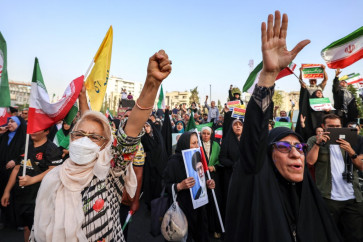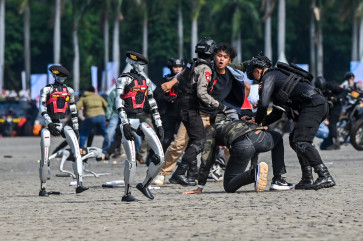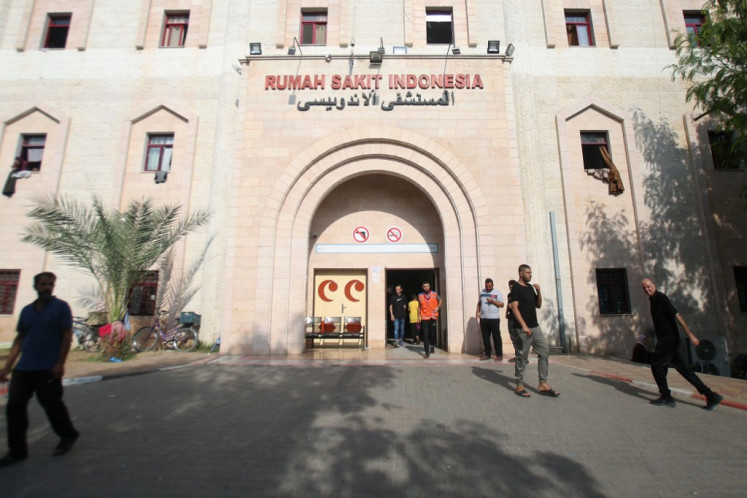Popular Reads
Top Results
Can't find what you're looking for?
View all search resultsPopular Reads
Top Results
Can't find what you're looking for?
View all search resultsLenders spend big on tech to draw customers
Viva la revolution: Finance Minister Sri Mulyani Indrawati (center) shares a light moment with Indonesia Banking Expo (IBEX) steering committee chairman Tigor Siahaan (left) and Bank Mandiri president director Kartika Wirjoatmodjo during the expo in Jakarta on Thursday
Change text size
Gift Premium Articles
to Anyone
V
iva la revolution: Finance Minister Sri Mulyani Indrawati (center) shares a light moment with Indonesia Banking Expo (IBEX) steering committee chairman Tigor Siahaan (left) and Bank Mandiri president director Kartika Wirjoatmodjo during the expo in Jakarta on Thursday. IBEX discussed the digital revolution and its impact on the banking industry. (Antara/Rivan Awal Lingga)
Banks are spending large amounts of money on technology every year to convince consumers to use their products and services, but challenges lie ahead as they face rapidly growing technology players that can either complement their businesses or become real competitors.
Bank Central Asia (BCA) president director Jahja Setiaatmadja said banks must really understand the type of consumers they were targeting, decide on what type of tech players or financial technology (fintech) firms they wanted to collaborate with and then invest on the right form of technology.
“Banks are now dealing with companies that are willing to ‘burn money’. They hardly make any profit, but their valuations continued to rise,” he said, referring to tech companies like app-based ride-hailing services.
By knowing the type of consumers they want to target, banks could then collaborate with technology companies to expand their market reach.
However, to ensure the effectiveness of their strategies, banks must first ensure they have three things: critical mass, their own ecosystem and attractive products to offer consumers.
The country’s largest private lender said it would invest Rp 5.2 trillion (US$354.37 million) next year in technological development, of which Rp 1.8 trillion will be used to improve its current information and technology systems and Rp 1.7 trillion for developing new systems to keep up with the increasing number of consumers and branches.
“We have just launched a QR code, which required a large budget [...] We also have to invest in legal, compliance and security systems,” Jahja said on the sidelines of the 2018 Indonesia Banking Expo on Thursday.
State-owned lender Bank Rakyat Indonesia (BRI) said finding the right talent to fill technology-related positions remained the one of the biggest challenges for banks to accelerate their digital business transformation.
According to BRI digital banking and information technology director Indra Utoyo, to ensure banks had the necessary tech talent to accelerate business growth, they must have in-house technology and digital capabilities.
Nevertheless, state-owned lender Bank Mandiri has allocated $200 million to develop its technology systems in 2019, up from $150 million in 2018.
“[We will invest] around $200 million next year. First, to expand our servers’ capacity. Second, to create new applications with digital banks,” said Bank Mandiri president director Kartika “Tiko” Wirjoatmodjo.
Despite the positive impacts technology has had in supporting the performance of local banks, there are also risks that have to be managed by Indonesian lenders when they decided to collaborate with fintech players, warned Finance Minister Sri Mulyani Indrawati.
“There are fundamental things that will not change even though banks have integrated fintech or other types of advanced technology into their businesses. The foundations of the financial industry are confidence and trust,” she said.
“Whether banks analyze customers using artificial intelligence or other approaches, the basis is the same; customers borrow money and you need to trust that they can return that money.”
Sri Mulyani also praised the banking industry for proving it has been able to withstand major crises. She was referring to Asia’s economic upheaval in 1998 as well as the 2008 global crisis.
Between 2011-2014, the banking industry also faced a major decline in oil, gas and coal prices, but once again, it was able to push through the bleak conditions.
Having faced and survived a series of tough challenges, Sri Mulyani said, Indonesian banks were in strong shape to face the potential trials and tribulations of Industry 4.0.










